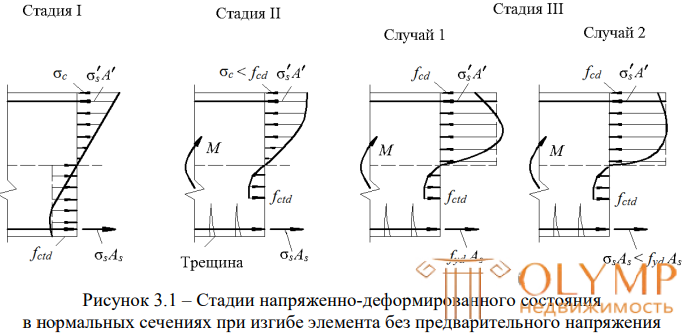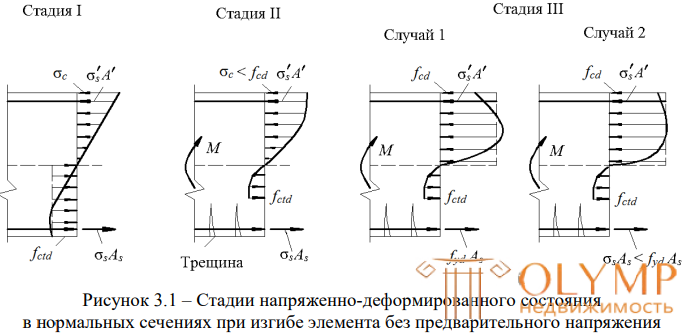
Bending work plates and beams of coatings and ceilings, various elements of the superstructures of bridges and racks, etc. Experiments have shown that the elements can be destroyed either over the cross section normal to the longitudinal axis of the element and located in the zone of maximum bending moments, or along an inclined section near the support.
The calculation establishes the required dimensions of the element and its reinforcement at given loads, providing strength in all sections.
1.section normal to the element axis
2. section inclined to the longitudinal axis

Stage 1.
At low loads, stresses in concrete and reinforcement are small, and elastic deformations develop predominantly in concrete. The relationship between stresses and strains is almost linear, and stress plots, both in the compressed and in the stretched zones, can be considered triangular
Stage 1a.
With increasing load, the stresses in the stretched concrete grow more slowly compared to the deformations. In the tensioned section of the section, plastic deformations develop; the stress profile here takes a curvilinear shape, and the stress in the concrete reaches the tensile strength  bt = Rbtn. In the compressed zone, the concrete experiences predominantly elastic deformations and the stress diagram is close to triangular.
bt = Rbtn. In the compressed zone, the concrete experiences predominantly elastic deformations and the stress diagram is close to triangular.
Stage 1a is the basis of calculations for the appearance of cracks.
Stage 2
With an increase in the load in the concrete of the stretched zone, cracks appear, gradually spreading up to the neutral axis; in places where cracks have formed, the concrete is turned off from work and stretches the stresses with perceived reinforcement. In the compressed zone, the stress pattern in the concrete becomes curvilinear. Stage 2 is the basis for calculating the deflections of bending moments and crack widths.
Stage 3
With a further increase in the growth of the crack, and the stretched zone is revealed, the stresses in the materials increase, and the beam is destroyed. In this stage, inelastic creep deformations cover a significant part of the compressed zone, and the stress pattern in concrete has a pronounced curvilinear shape.
The nature of the beam destruction depends on the degree of saturation of the section reinforcement. In normally reinforced beams, the bearing capacity of the tensioned reinforcement is usually somewhat lower than the bearing capacity of the compressed zone of concrete. Therefore, the stresses in the tensioned reinforcement reach the yield strength  s =
s =  m earlier than occur in the compressed zone of concrete stresses equal to the tensile strength of concrete in compression. At stresses in reinforcement equal to Rs =
m earlier than occur in the compressed zone of concrete stresses equal to the tensile strength of concrete in compression. At stresses in reinforcement equal to Rs =  m, plastic deformations of reinforcement sharply increase, the beam gets a large deflection, there is a significant opening and elongation of cracks. As a result, the stresses in the concrete reach the compressive strength Rbn, and the compressed zone of the concrete is crushed. Consequently, the process of destruction of a normally reinforced beam (case 1) is characterized by the fact that stresses simultaneously occur in the tensioned reinforcement and the compressed zone of concrete, which are equal to the calculated resistance.
m, plastic deformations of reinforcement sharply increase, the beam gets a large deflection, there is a significant opening and elongation of cracks. As a result, the stresses in the concrete reach the compressive strength Rbn, and the compressed zone of the concrete is crushed. Consequently, the process of destruction of a normally reinforced beam (case 1) is characterized by the fact that stresses simultaneously occur in the tensioned reinforcement and the compressed zone of concrete, which are equal to the calculated resistance.
If we sharply increase the saturation of the section with reinforcement, then the bearing capacity of the reinforcement may turn out to be significantly greater than the bearing capacity of the compressed zone of concrete (reheated section).
In this case, the compressive stresses in the concrete reach the Rbn value, and the concrete of the compressed zone will be crushed before the stresses in the tensile reinforcement reach the yield strength (case 2).
Strength properties of reinforcement will be underutilized. The use of overreinforced elements is not allowed.
Stage 2 is the basis for calculating destructive forces and limit states.
Что бы оставить комментарий войдите
Комментарии (0)